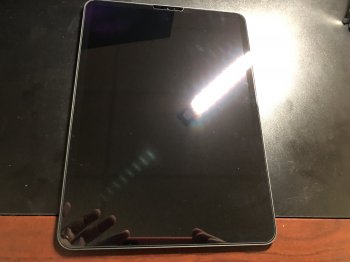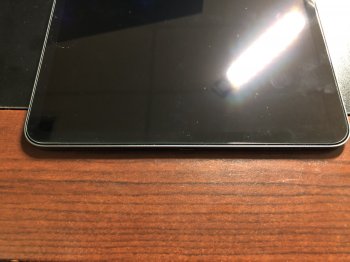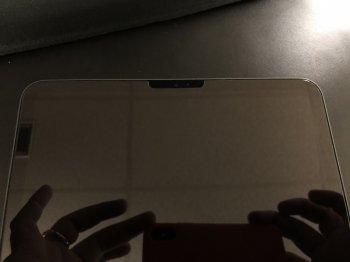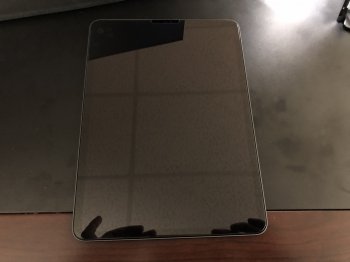Very happy to give my thoughts on the matter, but as a big caveat: I'll only usually speak out about something if I can provide assured information. To a large extent, I'm in the same boat as you here as it's a rather peculiar situation. I have a theory that you should take with a large pinch of salt and a tin hat, or ignore in preference of someone with greater insight:
You can find various threads around the internet for iPad Pro 12.9 (pre-2018) and iPad Pro 10.5 mentioning odd touchscreen issues, and I've put a few links below. From what we do as a business, we know that on very rare occasions, a touchscreen that comes off the production line is not as sensitive as the rest (more than the range of allowed tolerance agreed with the manufacturers) and that any normal thin plastic screen protector will affect touch responsiveness. We get 1-2 emails about this a year. It's the same thing for the proximity sensor - a tiny proportion of them aren't sensitive enough (or a lot, in the case of the Google Nexus 4). That's why most glass protectors don't cover the proximity sensor usually, as screen protector companies want to avoid the potential drama if something doesn't work.
https://discussions.apple.com/thread/8460564
https://www.ifixit.com/Answers/View...touchscreen+is+unresponsive+from+time+to+time
Here's an explanation of how a touchscreen works in case of interest:
https://matterchatter.wordpress.com/2012/06/16/how-does-the-iphone-touch-screen-work/
From our own historical testing, we know that the iPad Air 2 capacitive screen has a much lower sector accuracy than the iPad Pro 10.5" screen. That's because when we were testing our new Ultra-Tough material, it worked on all phones and all iPad Pros we tried, but strangely, not the iPad Air. We believe that, to reduce costs (or due to technological limitation at the time) the gridlines of the iPad Air's capacitive sensor grid were spaced further apart compared to the iPhones and the iPad Pro range (the latter of which came out a few years later and needed fine sensitivity to work with the Apple Pencil 1). You may be aware that when getting a phone screen repair from an unofficial outlet, it's usually not as touch sensitive, sometimes very noticeably so. It's because the Apple screens cost too much for private sellers and therefore these repair shops need to keep costs low, and an obvious way to reduce the cost is to reduce how many sensors there are in the screen. We looked into offering phone repairs a few years ago, and touch screens are sold in different grades depending on how well they perform.
I'm not suggesting Apple has cut costs, far from it, but perhaps some (or all) of the sensing grids are unintentionally a bit further away from the glass screen and therefore, like a lower-grade touchscreen don't detect the less obvious touches when a protector is applied. That would explain why the 12.9" sounds to be working okay for people, whereas the smaller 11" screen isn't. The descriptions people are providing here sound really awful, so it does suggest some kind of notable change, whether intentional or unintentional. Perhaps someone with a career in capacitive touch screens will now step in and correct me, let's see

There are different screen protector grades too in terms of touch responsivity, but it usually only affects privacy protectors. The cheap stuff doesn't allow the charge from your finger to pass throughm. I'm not aware of glass protectors messing up touch responsiveness before now, however, there is a huge variety in tempered glass screen grades (the really cheap stuff is literally $0.50 to buy, whereas the stuff used by the proper brands costs easily a few times more). Perhaps these iPads are exposing who went cheap and who didn't? I really couldn't say at this point, as the more premium glass protectors are thicker than the cheap stuff (despite what the marketing will have you believe about "ultra-thin 0.2mm glass").
I read someone say in this thread that Apple is telling people they don't need screen protectors for the new iPads and therefore they're not selling them. Pretty much every year, they tell us the new iPhone screen is notably harder than the last, and yet, they still sell screen protectors. It seems rather unusual that they are not selling screen protectors for the new iPads. Perhaps it's entirely coincidental, perhaps it's an intentional thing to kill off the screen protector market for marketing reasons (doesn't sound likely), or perhaps someone messed up and this is their way of spinning things to avoid needing to provide replacements? Who knows. If the iPads bought in early 2019 magically work with all screen protectors, I think that'll be a clue as to what happened here.






